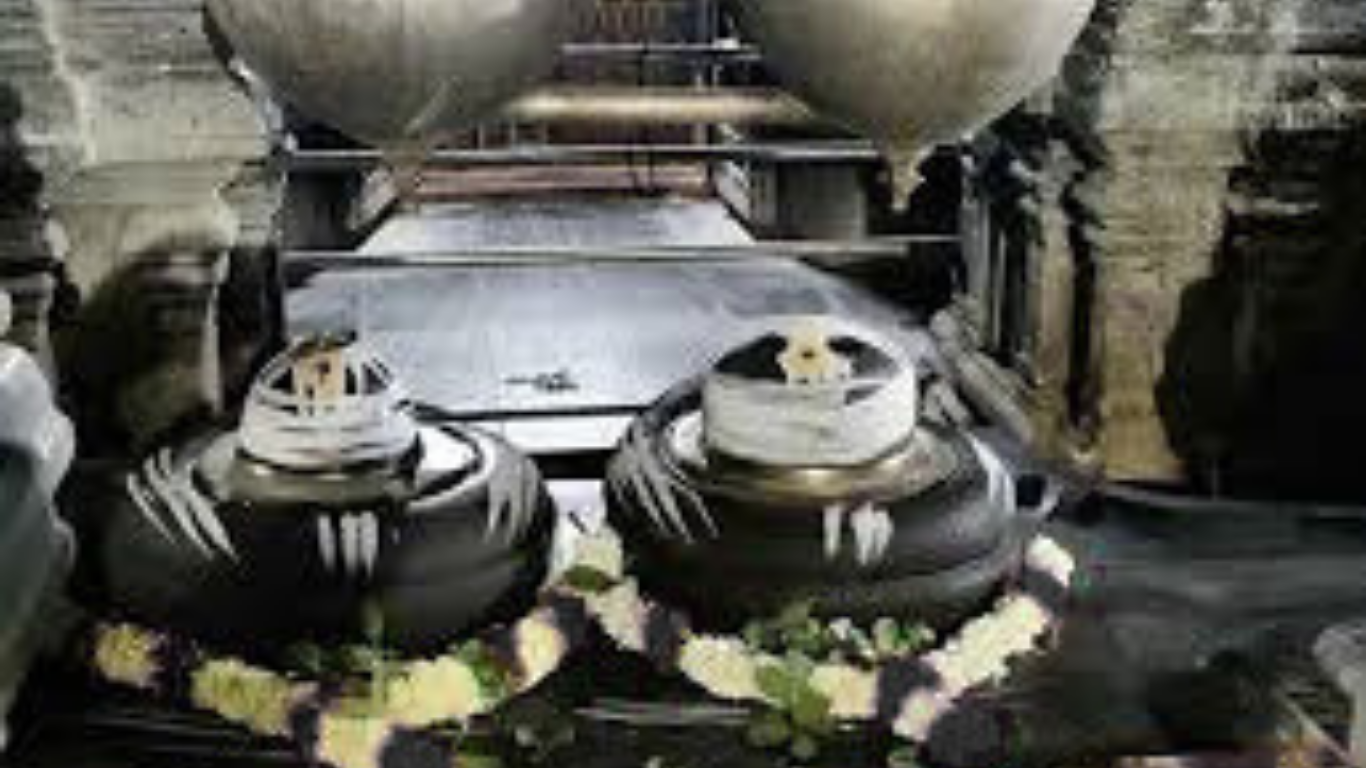Nestled in the heart of Telangana, the Kaleshwaram Temple, also called Kaleshwara Mukteshwara Swamy Temple, is a sacred spot that draws devotees and travelers alike. Located in Kaleshwaram village, where the Godavari and Pranahita rivers meet, this ancient temple dedicated to Lord Shiva is known for its unique double Shiva Lingas on a single pedestal. Often called the “Southern Kashi,” it holds deep spiritual meaning, offering peace and a chance to connect with the divine. This guide explores the temple’s history, significance, and what makes it special, along with practical tips for visiting. Whether you’re seeking blessings or curious about its cultural charm, the Kaleshwaram Temple promises a memorable experience. Let’s dive into its story and why it’s a must-visit destination.
The History of Kaleshwaram Temple
The Kaleshwaram Temple’s origins are steeped in legend and history. Built during the Kakatiya dynasty, around the 12th century, it reflects Dravidian architecture with intricate carvings. According to the Skanda Purana, the Godavari River did penance for Lord Shiva, who appeared as Mukteshwara. To balance the cycle of life and death, Lord Yama, the god of death, also prayed to Shiva, who allowed a second Linga, Kaleshwara, to be placed beside Mukteshwara. This unique feature—two Lingas on one pedestal—sets the temple apart. Known as one of the Trilinga Desham temples, alongside Srisailam and Draksharamam, it’s a key spiritual site in Telangana. Over centuries, it has been a place of worship, drawing pilgrims seeking salvation and peace. Its historical and spiritual depth makes it a treasure of Indian heritage.
Legends Behind the Temple
The temple’s story is tied to a fascinating legend. The Skanda Purana says the Godavari and Ganga rivers argued over which was holier. Godavari’s penance led Lord Shiva to appear as Mukteshwara, granting salvation to those who bathed in its waters and prayed at the temple. This caused an imbalance, as too many attained moksha (liberation). Lord Yama, tasked with maintaining the life cycle, prayed to Shiva, who permitted him to install a second Linga, named Kaleshwara. This dual Linga setup symbolizes life and death, making the temple unique. Another tale tells of a Vaishya performing an abhisheka with hundreds of milk pots, with the milk flowing into the Godavari-Pranahita confluence, earning the temple the name “Dakshina Gangotri.” These stories add a mystical charm to the temple’s spiritual allure.
Architectural Highlights
The Kaleshwaram Temple showcases Dravidian-style architecture, with detailed carvings on its pillars and walls. Built during the Kakatiya era, it features hints of Buddhist and Jain influences, with sculptures of Surya, Matsya, and Brahma. The temple’s entrance has a grand staircase, and its halls are used for festivals and rituals. A standout feature is the Mukteshwara Linga’s hole, which never fills with water despite continuous pouring—some believe it connects to the Godavari via an underground passage. The fish idol sculpture, symbolizing prosperity, is another draw. The temple’s serene setting by the river confluence enhances its beauty, blending nature and spirituality. Recent renovations by the Telangana government have preserved its ancient charm while improving facilities for visitors.
Spiritual Significance of Kaleshwaram Temple
The Kaleshwaram Temple is a spiritual powerhouse, revered as one of Telangana’s holiest sites. Its unique double Lingas—one for Lord Shiva (Mukteshwara) and one for Lord Yama (Kaleshwara)—represent liberation and the life cycle, offering devotees a chance to seek moksha. Known as a Trilinga Desham temple, it’s one of three sacred Shiva shrines in the Telugu region, alongside Srisailam and Draksharamam. The temple’s location at the Godavari-Pranahita confluence, with the mythical Saraswati River believed to flow beneath, earns it the title “Dakshina Triveni Sangamam.” Pilgrims believe bathing here and praying cleanses sins and brings blessings. The temple’s divine energy, especially during festivals like Maha Shivaratri, makes it a magnet for those seeking spiritual growth and peace.
The Dual Shiva Lingas
The temple’s defining feature is its two Shiva Lingas on a single pedestal, a rare sight. The Mukteshwara Linga, representing Lord Shiva, grants liberation, while the Kaleshwara Linga, installed by Lord Yama, symbolizes the balance of life and death. Devotees pray to Lord Ganesha first, then Yama, and finally Shiva, following a sacred ritual order. The Mukteshwara Linga has a mysterious hole that never fills with water, believed to connect to the Godavari River. This phenomenon adds to the temple’s mystical aura. The dual Lingas make Kaleshwaram a unique pilgrimage site, drawing devotees who believe prayers here can free them from the cycle of rebirth and bring spiritual fulfillment.
Festivals and Rituals
The temple comes alive during festivals, especially Maha Shivaratri and the Karthika month (November-December). Maha Shivaratri sees thousands of devotees chanting the Mrityunjaya Mantra and offering abhisheka to the Lingas. During Karthika, holy baths in the Godavari-Pranahita confluence from December 6-17 are a key ritual, believed to cleanse sins. Other festivals like Ugadi, Deepavali, and Ganesh Chaturthi are celebrated with joy. Daily rituals include abhisheka and Nitya Kalyanam Seva, with specific dress codes for men (no shirts in the sanctum). The temple’s vibrant rituals and serene riverfront setting create a deeply spiritual experience, drawing pilgrims from Telangana, Maharashtra, and beyond.
Visiting Kaleshwaram Temple
Planning a trip to Kaleshwaram Temple is straightforward, thanks to its good connectivity. Located in Jayashankar Bhupalpally district, it’s about 277 km from Hyderabad and 95 km from Ramagundam railway station. Buses run every 30 minutes from Hyderabad, Warangal, and other cities, with over 60 daily services. By car, take the Hyderabad-Siddipet-Karimnagar route (about 5 hours) or the shorter Hyderabad-Bhongir-Warangal route (4 hours 15 minutes). The temple is open from 4 AM to 1 PM and 3:30 PM to 9 PM, though timings may vary during festivals. Modest clothing is required, and photography is restricted in the sanctum. Book accommodations in advance, especially during peak seasons like Maha Shivaratri, to ensure a smooth visit.
How to Reach Kaleshwaram
Kaleshwaram is well-connected by road, rail, and air. The nearest airport is Hyderabad’s Rajiv Gandhi International Airport (289 km), where you can hire a taxi or take a bus. For trains, Ramagundam (95 km) or Kazipet Junction are the closest stations, with buses or taxis to the temple. By road, state-run TSRTC buses operate frequently from Hyderabad, Warangal, Karimnagar, and Vijayawada. Driving routes include Hyderabad-Siddipet-Karimnagar (300 km) or Hyderabad-Bhongir-Warangal (260 km). Local rickshaws and autos are available in Kaleshwaram. The scenic drive along the Godavari adds to the journey’s charm. Check bus schedules or book cabs in advance, especially during festivals, for a hassle-free trip.
Best Time to Visit
The ideal time to visit Kaleshwaram Temple is October to March, when the weather is cool and pleasant, perfect for exploring the temple and nearby riverfront. Summers (April-June) can be hot, making outdoor activities tough. The monsoon season (July-September) brings lush greenery but may cause travel delays due to rain. Festivals like Maha Shivaratri (February-March) and Karthika month (November-December) draw large crowds, so plan for busy days if visiting then. Early mornings offer a peaceful darshan with fresh prasad and shorter queues. Booking accommodations ahead during peak seasons ensures a comfortable stay, letting you fully enjoy the temple’s spiritual ambiance and serene surroundings.
Nearby Attractions to Explore
Kaleshwaram offers more than just its temple. The Godavari-Pranahita confluence, known as Dakshina Triveni Sangamam, is a serene spot for a holy dip or boating. The Pranahita Wildlife Sanctuary, nearby, is great for nature lovers, with its forests and diverse wildlife. Laknavaram Lake, about 60 km away, offers stunning views and boating. The Kaleshwaram Lift Irrigation Project, 35 km from the temple, is an engineering marvel worth a visit. Other temples, like the Vasavi Kanyaka Parameshwari Temple near Kaleshwaram, add to the spiritual journey. These attractions make Kaleshwaram a perfect blend of faith, nature, and culture for a fulfilling trip.
The Godavari-Pranahita Confluence
The confluence of the Godavari and Pranahita rivers, joined by the mythical Saraswati flowing beneath, is a sacred highlight near the temple. Known as Dakshina Triveni Sangamam, it’s a key spot for pilgrims who take a holy dip before prayers, believing it cleanses sins. The riverfront is serene, with steady water flow even in summer (15-20 feet deep). Boating is available, offering a peaceful way to enjoy the scenic beauty. Devotees perform rituals for the river before entering the temple, adding to the spiritual experience. The confluence’s tranquil setting and cultural significance make it a must-visit, blending nature’s calm with deep-rooted faith.
Other Nearby Sites
Beyond the temple, Kaleshwaram offers rich attractions. The Pranahita Wildlife Sanctuary, a short drive away, is home to diverse flora and fauna, ideal for trekking or wildlife spotting. Laknavaram Lake, 60 km away, is a picturesque spot for boating and picnics. The Kaleshwaram Lift Irrigation Project, 35 km away, showcases modern engineering amid scenic landscapes. Nearby, the Vasavi Kanyaka Parameshwari Temple, built in 2018, draws devotees with its vibrant rituals. For history buffs, Nagunur Fort (near Karimnagar) offers a glimpse into Telangana’s past. These sites combine nature, culture, and innovation, making your Kaleshwaram trip a well-rounded adventure.
Tips for a Memorable Visit
To make your Kaleshwaram Temple visit special, plan ahead. Arrive early for a quick, peaceful darshan—mornings are less crowded. Wear modest clothing (cover shoulders and knees) and avoid flash photography in the sanctum to respect the temple’s sanctity. Use authorized lockers for belongings and leave shoes with designated keepers. Take a holy dip at the Godavari-Pranahita confluence before prayers for a full spiritual experience. Book hotels or dharamshalas in advance, especially during festivals, via sites like YatraDham.org. Try local eateries for authentic Telangana food, and carry cash, as ATMs are limited. Respect temple staff and fellow devotees, and check festival schedules for a vibrant experience. These tips ensure a smooth, meaningful visit.
Preparing for Your Trip
Before heading to Kaleshwaram, check the temple’s website or local tourism offices for updated darshan and pooja timings, as they may change during festivals. Pack modest clothes and comfortable shoes for walking around the temple and riverfront. Bring a water bottle and small offerings like flowers or fruits, which are allowed. Book accommodations early, especially during Maha Shivaratri or Karthika month, when hotels fill up fast. Carry cash for local transport or small purchases, as digital payments may not always work. If driving, plan your route and check road conditions, especially in monsoon season. Knowing these basics helps you focus on the spiritual and cultural experience without any stress.
Respecting Temple Traditions
Respecting Kaleshwaram Temple’s traditions enhances your visit. Follow the ritual order: pray to Lord Ganesha, then Lord Yama, and finally Lord Shiva. Men must remove shirts and vests during abhisheka in the sanctum. Keep silence in the main sanctum and avoid using mobile cameras to maintain sanctity. Offer only permitted items like flowers or coconuts, and avoid non-vegetarian food or alcohol near the temple. Engage respectfully with priests and staff, even if responses vary, and consider lodging complaints with the temple office if needed. Taking a holy dip in the river before prayers is a cherished custom. Following these traditions shows respect and deepens your connection to the temple’s sacred atmosphere.
Why Visit Kaleshwaram Temple?
The Kaleshwaram Temple offers a unique blend of spirituality, history, and natural beauty. Its rare double Shiva Lingas, serene river confluence, and ancient architecture make it a standout destination. Whether you seek moksha, peace, or a cultural adventure, the temple delivers a profound experience. Festivals like Maha Shivaratri bring vibrant energy, while the calm riverfront offers tranquility. Nearby attractions like Laknavaram Lake and the Pranahita Sanctuary add variety to your trip.




